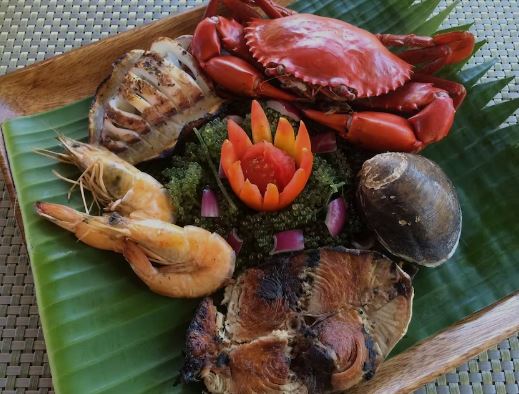Coron, located in Palawan, Philippines, offers a diverse range of culinary delights, combining local flavors with international influences for you and your whole family. Start your Foodie taste test today with the basic foods and slowly increase your food spectrum and by the end of the trip you might be ready to try Dinuguan (blood soup) or Balut (duck embryo eggs). Only the adventurous eater can stomach some of these Filipino delicacies.

Table of Contents
Foodie’s Guide:
- Fresh Seafood:
- Being a Foodie on island destination, Coron is renowned for its fresh seafood. Try local catches like tuna, grouper, crab, and prawns. Restaurants often serve them grilled, fried, or in various Filipino dishes.
- Lato Salad:
- Lato is a type of seaweed that’s often used in salads. The Lato Salad is a refreshing dish that typically includes tomatoes, onions, vinegar, and sometimes salted eggs.
- Adobo:
- Adobo is a Filipino staple, and you’ll find it in Coron as well. It involves marinating meat (often chicken or pork) in soy sauce, vinegar, garlic, and spices, then simmering until tender.
- Sinigang na Baboy (Pork Sinigang):
- A comforting and sour tamarind-based soup with pork, vegetables, and sometimes green chili. It’s a popular Filipino dish that varies in preparation across regions.
- Kinilaw:
- Kinilaw is the Filipino version of ceviche. It involves raw fish or seafood marinated in vinegar, calamansi (Filipino lime), ginger, onions, and chili.
- Crispy Pata:
- A Filipino dish consisting of deep-fried pork leg. It results in a crispy skin while keeping the meat tender and flavorful inside.
- Tamilok:
- For the adventurous foodie, try tamilok, a local delicacy. It’s a woodworm found in mangrove trees and is typically eaten raw or marinated in vinegar and spices.
- Balut:
- Balut is a fertilized duck egg with a partially developed embryo. It’s a Filipino street food that might be a unique culinary experience for some visitors.
- Chao Long:
- Coron has influences from Vietnamese cuisine, and Chao Long, a Vietnamese noodle soup, is worth trying. It usually includes rice noodles, beef or pork, and a flavorful broth.
- Calamansi Muffins:
- Calamansi is a small citrus fruit abundant in the Philippines. Coron is famous for its calamansi muffins, a sweet and tangy treat that makes for a great souvenir.
- Tahô:
- A popular Filipino street food, tahô consists of silken tofu topped with arnibal (sweet syrup) and sago pearls (similar to tapioca pearls).
- Halo-Halo:
- Cool down with a refreshing dessert called halo-halo, a shaved ice dessert with various sweet ingredients like beans, jellies, fruits, and leche flan.
When exploring Coron, don’t hesitate to try local eateries and markets for an authentic taste of Filipino cuisine. Always ask locals for recommendations to discover hidden culinary gems. The true essence of this adventure, however, lies not just in the food itself, but in the context of its enjoyment.
It is found in the bustling energy of the public market at dawn, the humble ambiance of a carinderia where shared tables foster connection, and the genuine warmth of a home kitchen. Or to the 4 or 5 star restaurants in the center or out- skirts of town. This Foodie approach to dining fosters a deeper, more respectful form of tourism—one that supports the local economy, values sustainability by prioritizing what is freshly caught and in-season, and creates meaningful cultural exchanges.
Ultimately, being a Foodie and leaving the familiar behind to eat like a local in Coron is the surest way to move beyond seeing the destination and to truly taste its soul, forging memories that are far richer and more lasting than any standard meal could provide. It is an unforgettable lesson in how a community’s identity, history, and relationship with nature are beautifully expressed on a single plate.


